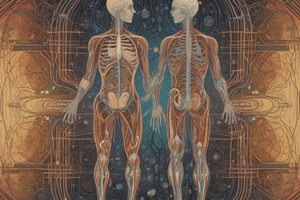Podcast
Questions and Answers
What is the primary function of negative feedback mechanisms in the body?
What is the primary function of negative feedback mechanisms in the body?
- To promote continuous increase of change
- To maintain homeostasis by counteracting fluctuations (correct)
- To reinforce changes and increase disturbances
- To initiate harmful feedback loops
Which of the following is an example of a positive feedback mechanism?
Which of the following is an example of a positive feedback mechanism?
- Increasing red blood cell production
- Regulating body temperature
- Enhancing uterine contractions during childbirth (correct)
- Maintaining blood sugar levels
What can result from the disturbance of homeostasis in the body?
What can result from the disturbance of homeostasis in the body?
- Enhanced efficiency of bodily functions
- Immediate recovery from diseases
- Improved internal environmental stability
- Development of pathophysiological states (correct)
Which statement correctly describes the nature of positive feedback mechanisms?
Which statement correctly describes the nature of positive feedback mechanisms?
How does a negative feedback mechanism respond to a rise in body temperature?
How does a negative feedback mechanism respond to a rise in body temperature?
What type of feedback mechanism is primarily used in homeostatic control systems?
What type of feedback mechanism is primarily used in homeostatic control systems?
Which class of control system operates alone to maintain internal stability?
Which class of control system operates alone to maintain internal stability?
What factors are influenced by the concentration of salt in the body?
What factors are influenced by the concentration of salt in the body?
What is the primary difference between the nervous system and the endocrine system in terms of control speed?
What is the primary difference between the nervous system and the endocrine system in terms of control speed?
Which of the following factors is NOT mentioned as being part of the internal environment's stability?
Which of the following factors is NOT mentioned as being part of the internal environment's stability?
What is the role of feedback in homeostatic control systems?
What is the role of feedback in homeostatic control systems?
The relationship between salt concentration and blood pressure can be described as:
The relationship between salt concentration and blood pressure can be described as:
Which of the following best describes intrinsic control systems?
Which of the following best describes intrinsic control systems?
What defines the internal environment of an organism?
What defines the internal environment of an organism?
Why is homeostasis important for an organism?
Why is homeostasis important for an organism?
Which of the following components is NOT part of a homeostatic control system?
Which of the following components is NOT part of a homeostatic control system?
How do the nervous and endocrine systems contribute to homeostasis?
How do the nervous and endocrine systems contribute to homeostasis?
Which factor is homeostatically regulated in the internal environment?
Which factor is homeostatically regulated in the internal environment?
Which principle best describes the negative feedback mechanism in maintaining homeostasis?
Which principle best describes the negative feedback mechanism in maintaining homeostasis?
In what way does a positive feedback mechanism differ from a negative feedback mechanism?
In what way does a positive feedback mechanism differ from a negative feedback mechanism?
What could potentially disrupt homeostasis?
What could potentially disrupt homeostasis?
Flashcards are hidden until you start studying
Study Notes
Lecture Overview
- Conducted by Dr. Safa Almaghrabi, Associate Professor in Clinical Physiology.
- Emphasizes understanding homeostasis and its critical role in maintaining an organism's internal environment.
Internal Environment
- Defined as the extracellular fluid (ECF) surrounding cells.
- Maintains essential concentrations of oxygen, glucose, ions, amino acids, and fatty substances necessary for cellular function.
Homeostasis
- Homeostasis maintains a stable internal environment despite external changes.
- "Homeo" means the same, and "stasis" refers to standing still.
- Proper functioning of organisms occurs efficiently within narrow optimal limits.
Importance of Homeostasis
- Essential for efficient functioning within the body.
- Chemical and physical states of the internal environment must remain within tight boundaries.
Homeostatically Regulated Factors
- Factors include:
- Nutrient molecule concentrations
- Oxygen and carbon dioxide levels
- Waste products
- Water, salt, and electrolytes
- pH levels
- Body temperature
- Plasma volume and blood pressure
Homeostatic Control Systems
- A network of body components maintains internal environment stability.
- Types of control systems:
- Intrinsic (local): operates within a specific area.
- Extrinsic (systemic): involves broader body systems.
- Major regulatory systems:
- Nervous system: provides rapid responses.
- Endocrine system: slower, long-term regulation.
- Operates mainly through negative feedback; positive feedback also plays a role.
Feedback Mechanisms
- Feedback involves responses after detecting changes.
Negative Feedback
- Corrective mechanism responding to changes in the opposite direction.
- Example: If body temperature rises, mechanisms are activated to decrease it.
Examples of Negative Feedback Mechanisms
- Regulation of red blood cell production.
- Management of blood sugar levels.
- Control of blood pressure.
Positive Feedback Mechanisms
- Enhance deviations, leading to further changes.
- Typically detrimental and can be lethal.
- Examples include:
- Uterine contractions during childbirth.
- Blood clot formation.
Consequences of Homeostatic Disturbance
- Pathophysiological states arise when systems fail to maintain optimal internal environments.
- Severe disruptions can be fatal.
Studying That Suits You
Use AI to generate personalized quizzes and flashcards to suit your learning preferences.




